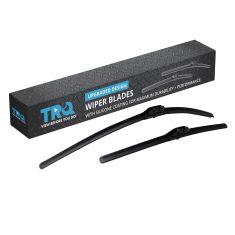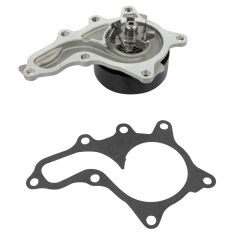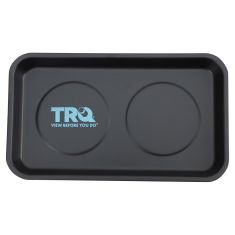Replaces
2011 Toyota Highlander L4 2.7L Engine Water Pump TRQ WPA07446
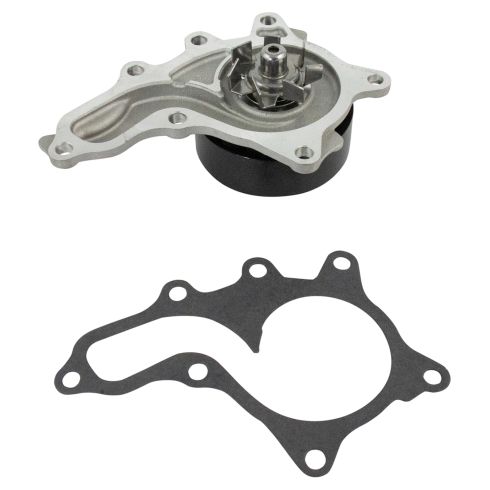

WPA07446
This part doesn’t fit a . Select from parts that fit.
Specify your vehicle's year, make and model to guarantee fit.
This part does not fit a .
Buy in the next and
Get it by: Tuesday, Dec 16 with expedited shipping
Recommended for your 2011 Toyota Highlander
Frequently bought together
Specify your vehicle's year, make and model to guarantee fit.
This part does not fit a .
Part Details
- Yes
- Aluminum
- 7
- No
- 2
- No
- Standard
- Cold Rolled Steel
- No
- 7
- 1.87 in
- No
- 3.74 in
Specifications
- L4 2.7L
About TRQ:
TRQ is a trusted brand dedicated to making every repair a success story by combining premium parts with easy installation. Each TRQ part is engineered by a team of automotive experts to meet or exceed OEM standards, delivering enhanced performance and maximum longevity. With rigorous in-house testing, the brand ensures superior fit and function across every product line. TRQ also provides customers with best-in-class, step-by-step installation videos—so you can complete repairs with confidence, whether you're a first-time DIYer or an industry professional.
Attention California Customers:
![]() WARNING: This product can expose you to chemicals including Lead and Lead Compounds, which are known to the State of California to cause cancer, and birth defects or other reproductive harm. For more information, go to www.P65Warnings.ca.gov.
WARNING: This product can expose you to chemicals including Lead and Lead Compounds, which are known to the State of California to cause cancer, and birth defects or other reproductive harm. For more information, go to www.P65Warnings.ca.gov.
Lifetime Warranty
This item is backed by our limited lifetime warranty. In the event that this item should fail due to manufacturing defects during intended use, we will replace the part free of charge. This warranty covers the cost of the part only.
FREE Shipping is standard on orders shipped to the lower 48 States (Contiguous United States). Standard shipping charges apply to Hawaii and Alaska.
Shipping is not available to a P.O. Box, APO/FPO/DPO addresses, US Territories, or Canada for this item.
Expedited is available on checkout to the United States, excluding Alaska, Hawaii.
Final shipping costs are available at checkout.


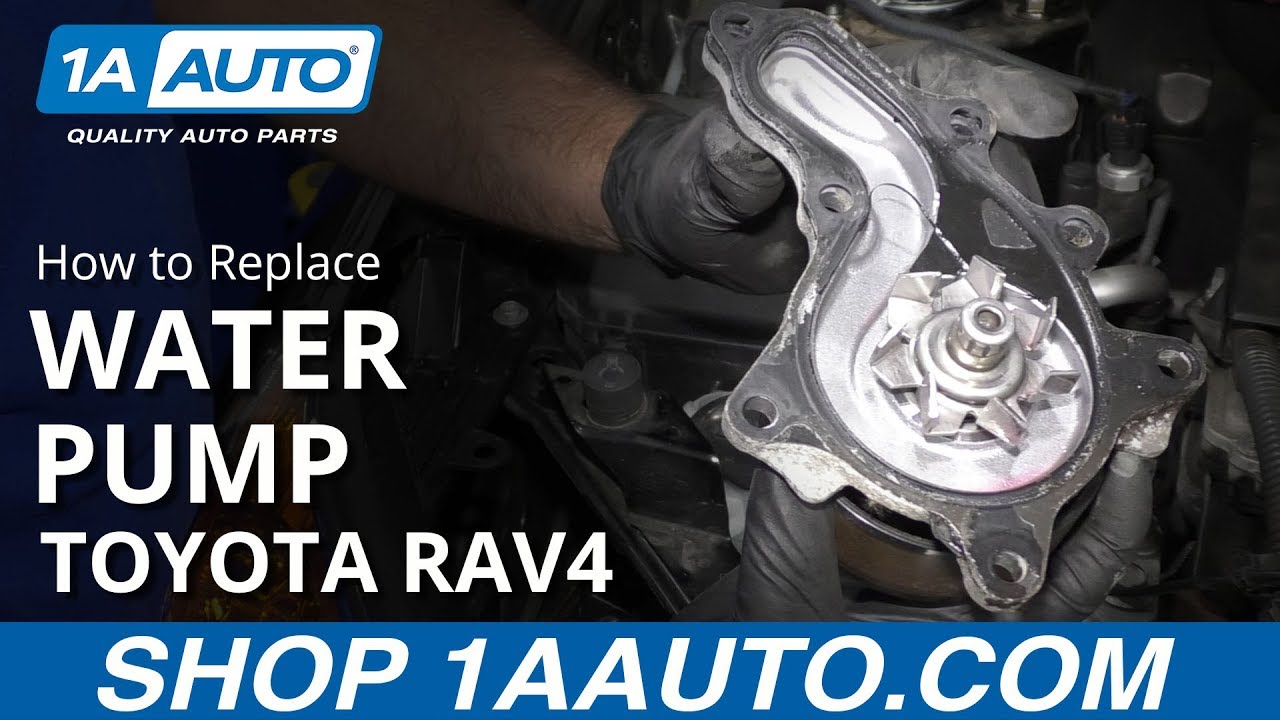
Created on:
Tools used
What's up guys? I'm Andy from 1A Auto. In this video I'm going to show you how to replace the water pump on this 2010 Toyota RAV4. If you need this part or other parts for your vehicle, click the link in the description and head over to 1AAuto.com.
From underneath the vehicle, we need to remove this panel right here. This one was pretty much falling off. There really wasn't much holding it on, but you should have some push pins right here, right here, right here, right here and over there. And then this one didn't have any of these fasteners, but there's some type of screws that go there, so you want to pull those off and slide this down and slide it out. Get that out of your way.
All right. I want to loosen up the drain on the bottom of the radiator right here. It's below the radiator hose right there. Loosen that up. Make sure you have a drain bucket underneath and actually it's pretty tight, so I'm going to take some pliers. Now be careful with this because if it breaks, then you're going to have to replace the radiator. If it doesn't move with pliers easily, then don't even bother with it. Just drain it with the hose or something else. Here we go.
Just going to let that drain slowly. Now I'm going to take the cap off. This is going to make it drain a little bit faster. A little bit faster. I'm going to pull this trim panel off. Take these little push clips out. What you do is you push down just a little bit on the clip and just slide it out. Just use a pocket screwdriver or a pick. Just grab that panel, slide it out. Now take a 10 millimeter socket extension and a ratchet. I'm using an electric ratchet. If you don't have an electric one, just use a regular one. Take these two bolts out. One here and there's one on the back right there.
Just going to use some pliers. You can use special hose clamp pliers for this, but regular ones work too. Remove this hose clamp and this one as well.
All right. So we're just trying to break the seal with the hose and slide it off because sometimes you just can't get the hoses off. So if you just take a little pick, get underneath the hose, go all the way around, and then you can slide that hose off just like that. And there's the reservoir. Be careful. I'm going to use a 10 millimeter wrench and disconnect the negative terminal on the battery. Just slide that off and out of the way. Now I'm going to take the serpentine belt off. I'm going to use this belt tensioner tool. This is a 14 millimeter socket on the tensioner tool. You could probably try to use a 14 millimeter socket and a ratchet if you don't have this tool.
And I'm going to turn this clockwise. I'm going to try to grab the belt off the alternator. Just slide it off. And sometimes it's kind of hard to get it off the alternator. So if you can reach down to the water pump pulley, slide it off that pulley, might be a little bit easier. Yep, that's a little easier. Slide that off and then loosen up the tension on the tensioner.
Take that off. The serpentine belt, you can leave it right there if it's just out of your way. If you want, you can take it off completely. We'll just leave it there. Great. Now we want to disconnect the alternator. Pull this cover off right here. If you're having trouble getting the cover off, just get a pick from underneath, pull that off. Then use a 10 millimeter socket and a ratchet. Take this bolt out, take this nut out and it is crucial that you have the battery disconnected while you're doing this. You don't want to arc out. All right, so this nut was really tight so I'm switching to a longer ratchet. Use a little more leverage. There we go. Just hold the cable. That'll prevent something from breaking or should prevent it from breaking.
Take this nut off. And we're going to take this bolt out. This just holds a wiring harness on right there. It's just the bracket. Use a 10 millimeter socket and ratchet this bolt out. Just like that. And then also this bracket, it's just in my way, so I'm just going to take this bracket off as well. Same 10 millimeter bolt and a ratchet. Then that can be moved. There's a connector right there. Disconnect that connector. Should be a lock button on the side. Disconnect that. So you just push down. You just push down right there on both sides. Then you can release that connector. That's released. We want to take this bolt out right here. I'm going to use a 14 millimeter socket and a ratchet.
Take that bolt out. Switch to an electric ratchet. Grab the bolt, slide it up, and there's another bolt at the base right here. Kind of hard to see, but I'm going to use that same 14 millimeter socket and ratchet. Break it free. It's on there really tight.
All right, let's grab that lower bolt. Be careful if you're using a electric ratchet or an air ratchet. You don't want to get your ratchet stuck against the frame of the vehicle. Pull that bolt out and just grab the alternator. Try to wiggle it a little. If it gets stuck up against this, you can grab a pry bar and try to pry it out a little bit. Let's try that. Carefully pry on this. You don't want to pry too much because you might crack one of the ears or something. Just go back and forth a bit.
All right. Let's slide that out. Just get the wiring harness out of your way. Just have to twist this. Let's get past the hoses and slide the alternator up. There it is.
All right so when I go to take the bolts out for the water pump, I am going to reference our new water pump. So there's bolts here, up top, that's three up top and four down below. So keep that in mind when you're trying to take those bolts out. Just take a 12 millimeter ratchet, a 12 millimeter socket, extension and a ratchet. We'll loosen these up.
To make it easier to get to one of the bolts, I am going to take the belt tensioner out and use a 12 millimeter wrench to loosen up the center bolt on the tensioner. And once you get it broken loose, you should be able to do it by hand. And just pull the tensioner out with the bolt, set it aside. So if you're struggling to get these two bolts underneath from up top, you can take this panel off and take the tire off.
All right. I raised and supported the vehicle. I'm going to remove the wheel. I'm using a 21 millimeter socket and an air gun. If you don't have an air gun, you can use a breaker bar. Just crack the lug nuts free while the vehicle is still on the ground.
Now I want to take the tire off. This one's stuck on there pretty good, so I'm going to put one lug nut on so the tire doesn't go flying. All right. So this tire is on there pretty good. So what I'm going to do is leave one lug nut on there and just hit it on the backside of the tire with a hammer. Break it free. Reason you'd leave the lug nuts so the tire doesn't go flying. Take the lug nut off and you pull the tire off. All right. I want to take this pushpin out here, here, there's one here, and normally there's probably one here. This vehicle doesn't have that. I'm just going to use a trim tool. Pop these out, pop the center out first. Pop those out just like that.
Now we're going to take this panel off, slide it towards the back of the car, slide it out of the way. Get underneath here with the ratchet. It's a little bit easier. It's still pretty, pretty difficult to get to, but at least you can see them when you're doing it this way. All right, you got all those bolts out. I'm just going to take a pry bar or a screwdriver. There's a little ear right here. You can release the water pump right there. Just be careful. If you try to release it right here and it seems like it's stuck, you may still have another bolt in there, so double check. Slide it out. You want to make sure you get the gasket with it. Pull the water pump up. There you go. Here's the old part and gasket. Here's the new water pump and gasket from 1AAuto.com. As you can see, the shape of the part is the same. The impeller is the same. Backside the pulley is the same, has the same bolt holes. Get yours at 1AAuto.com and you'll be ready to rock and roll.
All right, so I just want to clean this surface area up. You want to get any of the gasket material that's still on there off. I'm just going to use a razor blade. Be careful if you're using a razor blade, you can use a gasket scraper or a plastic razor blade sometimes works, but somehow try to get that extra gasket off. All right, I'm just taking a little cleaning pad and using a little bit of break clean on here. Just to clean up the gasket material. You can just use a rag. It doesn't have to be with this pad. This is just basically like a sponge.
Just clean that area up. We're going to take the gasket. Line it up with the water pump and just make sure you don't have anything on the gasket. You don't want to put any RTB on this or anything. Just slide this in position and I'm just going to take one of the bolts. Get the bolts started through the pump, through the gasket. Just line this up right there. Once you get one in, it'll be easier to get the other ones in. This other top one just like that and we'll get the rest of the bolts started before we tighten them down.
All right, now we'll just take a 12 millimeter socket and an extension and ratchet and snug these up. Not tight at all because I'm going to go back and torque them. Now we'll take that 12 millimeter socket and I'm going to use a torque wrench and torque these to 15 foot pounds, 15 foot pounds. You just go around and torque them all down. Now we can put the tensioner back on. Just slide it in position. There's that little ear you want align that ear up. I have the bolt in the tensioner already and just try to get it started. All right.
I'll take the alternator, slide it back in position. Move these wires out of your way.
All right. And try to get those two ears lined up. Top first. Take the bolt. Just wiggle it back and forth. Just trying to get this bolt started. Once you get that started and I'll try and get the lower one in. Okay, so that one's started. Take the lower bolt, it's going to go in down here and just slide it up a little bit and get those threads started. Now take a 14 millimeter socket and a ratchet. Tighten these bolts up.
Just go back with a hand ratchet and just snug them up. That's good. That's good. I'm going to take these bolts, install this bracket right here, and then this another bracket, it goes right there. Get those brackets started. Take a 10 millimeter socket and a ratchet, tighten them up.
Tighten that up. Take this electrical connector, plug that into the alternator, lock it in place. Then we have this positive terminal. It's going to go on the alternator. It is keyed, so try to get that to line up with the queues. Pull that cover to the side and this one just fell off. So we'll just put it on after. Install the nut. Now because it's a little bit important, I'm going to torque this. I'm going to use a 10 millimeter socket and a torque wrench and torque this nut to 87 inch pounds. Make sure you're on inch pounds, not foot pounds, because you don't want to torque this too much or over torque it. You could snap that off. So that's pretty important.
Take this cover, just slide it over the wire first like that and then cover it up. Right. Now I have to get the belt back on. All right, so we tried to get the belt on from up top and it's very difficult, so we're going to go from underneath the vehicle. This is definitely the way to go. It's a lot easier. Make sure the belt goes over the alternator, up top, and I'm going to have it come around the water pump. Make sure it's around the crank shaft pulley right there. And there's some little nubs right here, so make sure the belt goes above those nubs. All right, that's good. Then I'm going to hold it right over the A/C compressor. Take the tensioner tool with a 14 millimeter socket on it and loosen up the tension and slide it over the A/C compressor.
Just like that. Loosen up the tensioner and just double check. Make sure all the ribs in the belts are in with the ribs on the pulleys and they look good. All right, we'll just take this panel, slide this back in position. Just like that. Take the push pins, put push pins back in right there, right here, right here. And then if you had that one, put that one in there and then you can put the tire back on.
Install the tire. Take the lug nuts, install the lug nuts. Now I load the vehicle down to the ground so that the tire's just touching the ground and I'm going to torque these with a 21 millimeter socket and a torque wrench to 76 foot pounds and I'm going to do this in a star pattern. The reason you do it in a star pattern is so that the wheel gets tightened down evenly.
And then I always like to go around again just to double check. And you're good to go. All right, we'll just slide this coolant reservoir hose on the bottom and then this one goes on the top just like that. Take some pliers or some hose clamp pliers and reattach these hose clamps in the right position. I like to, if you can see where it was on the hose, try to put the hose clamp in the exact same spot that it was. You can see where it's indented. Generally, that makes it seal a lot better if it goes back the way it came off. That right there, just like that. Perfect. Take the two bolts. One goes right there and one goes in here. I'm going to use a 10 millimeter socket extension and ratchet. Tighten these bolts down.
And just snug it up. Same with this backbone.
There we go. Make sure that coolant drain is closed all the way. Just grab it and just give it a twist. You can try loosening it and just snug it up. You don't want to tighten it too tight, just finger tight and then maybe just a little bit more. So that's good. So if you have this panel, just line this up, right like that. Just position that there. So if you have the screws or bolts that go in there, put those back in and any of the push pins, they'd go in there, there. There's a couple of other spots there and there. Right there and there. All right. Then you're going to connect the negative terminal on the battery. Take a 10 millimeter socket. I mean, 10 millimeter wrench. Tighten this down. Just snug that down and then just make sure. Wiggle it, make sure it's nice and tight. Then you just take this cover. I'm going to just slide this back in position like that. Make sure everything lines up. And now we're just going to have to reset these pushpins. Just push this tab back so the centerpiece is popping out like that. Slide it in position and then push the button down so it's flush. Do that for all of them.
All right. Now we're going to take this coolant funnel and for this particular vehicle, I don't need any adapters. I can just put this coolant funnel here. This funnel comes with different adapters. We actually sell this at 1AAuto.com if you want one. We're going to take the appropriate coolant. You're going to want to check the owner's manual and make sure you use the right coolant for the vehicle. Now we'll fill it up.
As you fill this up, it may take a little while, so you might find that the reservoir completely fills up with coolant and then just let the vehicle sit for a little while. It's going to have to bleed itself into the engine. There may be some air pockets, so just be patient. Fill it up and let it bleed.
As you can see, it's about two minutes later and it drained back down. So just keep doing that. Fill it up, let it sit for a minute and watch it drain.
So once you've noticed that the level stays at one level for a little while, what you can do is go over to the radiator hose and give it a squeeze and see if you can get any air bubbles out of it. See if you can get it to bleed a little bit more. It looks pretty good right there.
Then what you're going to want to do is start the vehicle, let it run, put the heat on low speed and monitor the coolant temperature. Make sure the coolant temperature does not get over 210 degrees or into the red zone. And as long as you feel heat, it should be good. And then you're going to shut the vehicle off for a little while. And then once it cools down, recheck your level and adjust accordingly. Take the funnel out, take the cap, put the cap back on. Lock it in place.
Thanks for watching. Visit 1AAuto.com for quality auto parts shipped to your door. The place for DIY auto repair. And if you enjoyed this video, please click the subscribe button.
Tools used
WPA07446
877-844-3393
Monday - Friday 8:00am - 9:30pm ET
Saturday - Sunday 8:00am - 4:30pm ET
Specify your vehicle's year, make and model to guarantee fit.
This part does not fit a .




